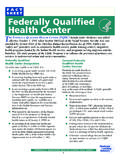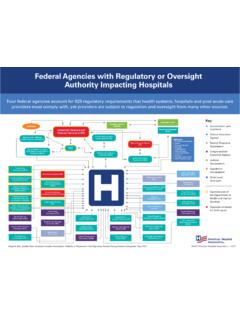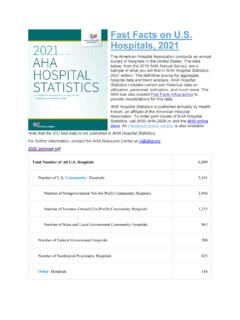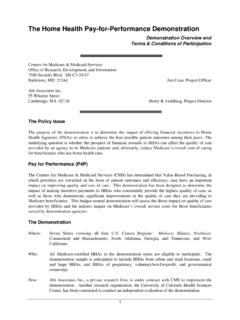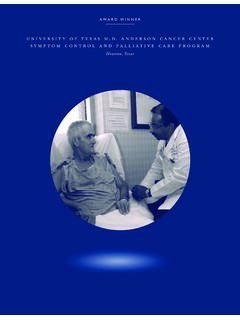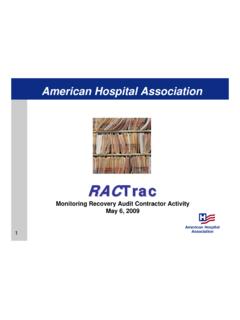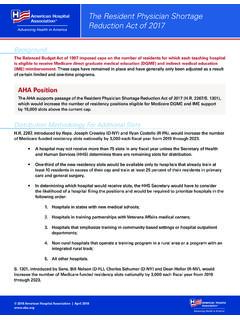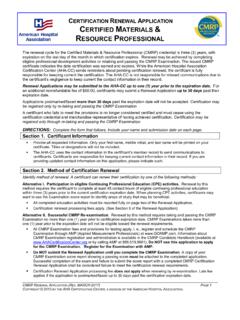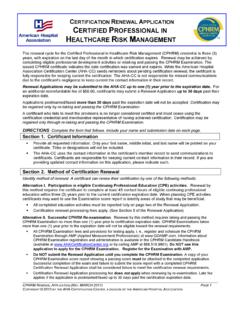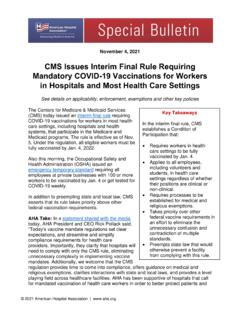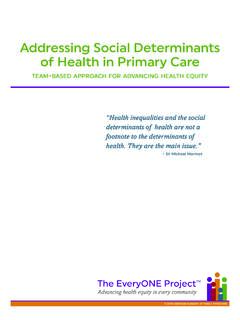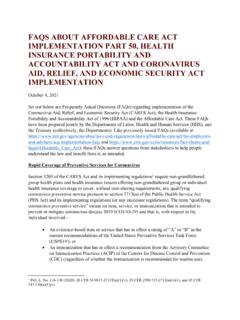Transcription of Improving Patient Safety and Health Care Quality through ...
1 Improving Patient Safety and Health care Quality through Health information TechnologyAMERICAN HOSPITAL ASSOCIATIONANNUAL SURVEY IT SUPPLEMENT BRIEF #3 JULY 20181 The potential to improve Patient Safety and Quality through better information sharing and guidance around best practices is a critical component of the value proposition for Health information technology (IT) systems. Nationwide efforts, including the Medicare and Medicaid Electronic Health Record (EHR) Incentive Programs, supported the expansion of Health IT that enables the sharing of clinical information . Advantages include sharing images and Patient records, supporting clinicians through improved access to data and best practices for care , and contributing to Patient Safety through tools such as medication New care delivery structures depend on EHRs and Health IT systems to collect, use, and track data necessary to deliver high- Quality , value-based, coordinated and Health systems increasingly use EHRs and other Health IT tools to support Patient Safety and improve care delivery.
2 These tools have varying capabilities, but core functions include capturing clinical information such as physician and nursing notes, test results, prescriptions, and problem lists and ongoing monitoring and analysis of Patient status indicators and outcomes. While the promise of Health IT for Quality and Safety improvement has begun to materialize, there is still more to achieve. This brief is the third in a series highlighting survey results from the 2016 AHA Annual Survey information Technology Supplement for community hospitals collected November 2016 April This brief focuses on the use of Health IT by hospitals and Health systems to improve Patient Safety and Health care Quality . Advancements in capabilities promote Patient Safety and Quality careHospitals and Health systems have significantly increased their use of Health IT for Quality improvement and Patient Safety as system capabilities have expanded.
3 These efforts support the broader Safety and Quality improvement work in which hospitals continuously DocumentationSince 2012, many hospitals and Health systems have implemented Health IT systems for Patient information and test results, meaning that an electronic system has completely replaced paper records for those functions. Some of the most significant improvements over Health IT-based supports for Patient care information have expanded quickly since 1: Hospital/ Health System Electronic Documentation of Patient Data and Results Implemented Fully or in At Least One Unit, 2012 and 2016/2017 2012 2016/2017 Clinical documentation of physician notesClinical documentation of discharge summariesDiagnostic test results59%95%81%97%82%92%2the past several years have been in the ability to capture clinical information (Chart 1).
4 Ninety-seven percent of hospitals and Health systems report that their Health IT systems allow electronic clinical documentation of discharge summaries, up from 81 percent in 2012; similarly, the ability to electronically document diagnostic test results increased from 82 percent to 92 percent over the same time period. Electronic clinical documentation of physician notes has increased dramatically with 95 percent of hospitals and Health systems reporting that capability, up from 59 percent in 2012. The electronic capture of Health information supports greater access to relevant information and the sharing of Patient information to support care and Medication SafetyHospitals and Health systems have integrated Patient Safety support into their Health IT systems and built in functions that reduce the risk of error (Chart 2).
5 Ninety-seven percent of hospitals and Health systems now have electronic prescribing of medication and integrated computerized provider order entry (CPOE). In almost all hospitals, the Health IT system allows providers to compare a Patient s inpatient and preadmission medication lists, while 94 percent have an electronic system that uses bar coding for Patient verification. The use of these tools helps providers ensure that the correct drugs are delivered in the right dosage to the correct Patient , as well as ensure proper accounting for medication during and after a hospital Support and High-Risk Monitoring Decision support systems can also alert clinicians to abnormal test results, potential clinical diagnoses, contraindications for drugs or possible drug interactions, or other information that might warrant urgent clinical intervention, prompt faster and more accurate diagnoses, or reinforce clinical treatment plans.
6 Most Health IT systems can display information to support provider decision-making, such as clinical guidelines (Chart 3). Ninety-two percent of hospitals and Health systems have implemented decision support through the display of clinical guidelines in their Health IT systems, up from 64 percent in 2012. Clinical decision support, when integrated with Health IT, can include alerts and reminders, clinical guidelines, condition-specific order sets, focused Patient information , and other tools to inform decisions by providers and patients related to diagnosis and treatment. Clinical decision support holds great promise for Improving care Quality ,3 but it must be designed and integrated into decision-making processes carefully and addition to Improving access to critical information about Patient care and Safety for providers, hospitals and Health systems are increasingly leveraging Health IT proactively identify risks and to prevent patients from suffering set-backs (Chart 3).
7 Sixty-eight percent of hospitals and Health systems reported that they use electronic clinical data to identify high-risk patients for follow-up care , 15 percentage points higher than only two years ago. Recent studies show that this newer, more sophisticated type of data analysis can help hospitals and Health systems identify potential problems in time to intervene with support efforts such as case management to ensure positive Patient AheadHospitals and Health systems have made significant improvements in their Health IT systems in recent years, integrating functions that improve their ability to deliver high- Quality care and monitor Patient Safety . The overall trend has reflected improvement in the percentage of hospitals and Health systems that report the capability to use their Health IT system for clinical decision support, to monitor Patient Safety , and to track Patient outcomes, including high-risk Hospitals and Health systems have moved quickly to adopt Health IT supports for Patient Safety and 2: Hospital/ Health System Computerized Patient Safety and Quality Tools Implemented Fully or in At Least One Unit, 2012 and 2016/2017 2012 2016/2017 Computerized provider order entry of medicationsBar coding for Patient verification72%97%68%94%3patients who may require additional care .
8 These activities enable hospitals and Health systems to more effectively identify progress on Patient -specific issues and Quality initiatives, as well as broader population Health concerns. The use of computerized order entry of medications and bar coding for Patient verification can help reduce prescription and other errors as well. While Health IT systems have great potential to improve Patient Safety and help ensure high- Quality Health care , they also may present unintended As Health IT systems become more integrated in the delivery of Health care and the monitoring of Safety and Quality , how providers interact with those systems as users will be increasingly important. Health IT that is poorly designed or applied may contribute to miscommunication, delay, confusion, or Decision support tools that are not usable may be ignored or, worse, interfere with the delivery of high- Quality Patient Furthermore, adverse events with the potential to cause significant harm, such as delayed diagnosis, medication errors, and incorrect treatment decisions, have been associated with the use of Health I It will continue to be important to understand not only the rates of adoption and IT capabilities in hospitals and Health systems, but also how those systems can best be designed to support Patient Safety and high- Quality Health care .
9 There also are challenges associated with using Health IT for reporting requirements, such as Quality Some concerns relate to the reliability or validity of the measures themselves, while others relate to the integration of reporting requirements into Health IT. For example, an AHA report looking at four hospitals experiences with implementation of the Medicare EHR Incentive Program s Meaningful Use Stage 1 electronic clinical Quality measures found that, in addition to other challenges, the program created distinct electronic data capture requirements for reporting, adding to providers workload with no perceived benefit to Patient care . Furthermore, no usable data to support Quality improvement efforts was generated as a result. Finally, differences in Health IT capabilities affect how successful hospitals and Health systems may be in participating in new payment and care delivery models that emphasize improved Patient Quality and Safety .
10 The ability to collect and use electronic data supported by Health IT systems to improve care delivery and Safety is a critical element of these models that directly affects participation and payment. The fourth issue brief in this series will look at hospital and Health system participation in new models of care delivery and payment which involve greater use of Health IT to support improved Patient outcomes. POLICY QUESTIONS1. What are best practices in Health IT implementation and use that maximize Patient Safety and Health care Quality ?2. How should Health IT systems be designed and deployed in ways that maximize usability and minimize risk? 3. How should Quality reporting functions be integrated into Health IT systems to support efficient reporting without negatively affecting provider practice or Patient care ?
